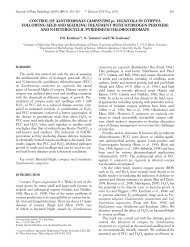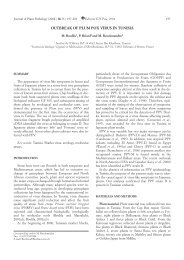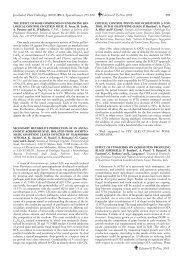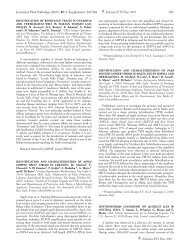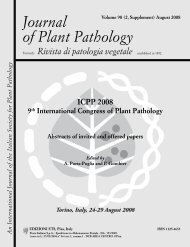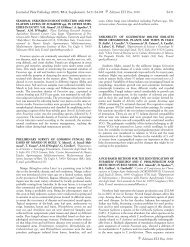Journal of Plant Pathology - Sipav.org
Journal of Plant Pathology - Sipav.org
Journal of Plant Pathology - Sipav.org
Create successful ePaper yourself
Turn your PDF publications into a flip-book with our unique Google optimized e-Paper software.
<strong>Journal</strong> <strong>of</strong> <strong>Plant</strong> <strong>Pathology</strong> (2011), 93 (1, Supplement), S1.19-S1.26 S1.23<br />
In the endosphere, the arbuscular mycorrhizal fungi (AMF) may<br />
play an important role in host plant disease resistance. The objective<br />
<strong>of</strong> the present study was to test if inoculation <strong>of</strong> maize plants<br />
with the arbuscular mycorrhizal fungus, Glomus intraradices, alters<br />
the interaction among plants, indigenous microbial communities<br />
in the rhizo- and endosphere <strong>of</strong> maize, and WCR root feeding<br />
and development. The experiment was carried out in a greenhouse,<br />
in pots containing Chernozem soil. The maize cultivar used<br />
was the commercial line KWS13. Four different treatments were<br />
established: (i) control maize plants grown for eight weeks; (ii)<br />
maize plants grown in soil inoculated with G. intraradices before<br />
sowing; (iii) maize plants subjected, after the 4th week <strong>of</strong> growing,<br />
to WCR larval feeding; (iv) maize plants grown in soil inoculated<br />
with G. intraradices before sowing and subjected after the 4th<br />
week <strong>of</strong> growing, to WCR larval feeding. Eight weeks after sowing,<br />
the plants were harvested in order to (i) evaluate the larval<br />
feeding effect on the dry biomass <strong>of</strong> the roots; (ii) investigate the<br />
AMF communities in the maize roots by PCR-RFLP; (iii) analyse<br />
the fungal and bacterial composition in the rhizosphere and in the<br />
endosphere <strong>of</strong> maize by DGGE (denaturing gradient gel electrophoresis).<br />
In parallel, the larvae, which had fed for four weeks<br />
on the roots were extracted from soil <strong>of</strong> treatments III and IV, to<br />
evaluate the larval stage and the developmental level <strong>of</strong> the 3 rd instar<br />
larvae. <strong>Plant</strong> root biomass measurements showed that G. intraradices<br />
did not affect significantly larval feeding <strong>of</strong> the roots.<br />
Analysis <strong>of</strong> the total number <strong>of</strong> larvae and <strong>of</strong> the composition <strong>of</strong><br />
larval instars revealed that G. intraradices did not influence the total<br />
number <strong>of</strong> WCR larvae but reduced significantly their development<br />
for the weight <strong>of</strong> the 3 rd larval stage was significantly lower<br />
in Glomus-treated plants in comparison with the controls<br />
(P=0.02). RFLP analysis <strong>of</strong> AMF populations showed that the soil<br />
inoculation with G. intraradices reduced the AMF evenness in<br />
maize roots almost exclusively to the RFLP type 11 (G. intraradices).<br />
ITS- and 16S-DGGE analysis showed a specific shift<br />
in both bacterial and fungal composition in the roots <strong>of</strong> plant colonized<br />
with G. intraradices. The additional dominant bands in the<br />
ITS-DGGE pr<strong>of</strong>ile were identified by sequencing as G. intraradices.<br />
In conclusion, this work showed that G. intraradices<br />
significantly reduced larval development. Furthermore, the shift<br />
<strong>of</strong> bacterial communities in the endosphere <strong>of</strong> G. intraradices-inoculated<br />
plants, suggests that other micro<strong>org</strong>anisms may be involved<br />
in decreasing the developmental level <strong>of</strong> larvae. However,<br />
the colonization <strong>of</strong> maize plants with G. intraradices should be<br />
further studied as an option to control WCR larvae in the framework<br />
<strong>of</strong> integrated pest management strategies.<br />
HEALTH PROTECTION OF STRAWBERRY IN MON-<br />
TENEGRO. N. Latinovic 1 , J. Latinovic 1 , S. Hrncic 1 and D.<br />
Sukovic 2 . 1 University <strong>of</strong> Montenegro, Biotechnical Faculty, Mihaila<br />
Lalica 1, 20 000 Podgorica, Montenegro. 2 PI Centre for Ecotoxicological<br />
Research <strong>of</strong> Montenegro, 20 000 Podgorica, Montenegro.<br />
E-mail: nlatin@ac.me<br />
During the last three years, strawberry became an important<br />
crop in Montenegrin agriculture with more than 1,500,000 plants<br />
planted. During 2010, four strawberry fields were monitored,<br />
taking into account problems caused by harmful <strong>org</strong>anisms that<br />
jeopardize crop health. The most important diseases were strawberry<br />
leaf spot (Mycosphaerella fragariae (Tul.) Lindau) and grey<br />
mold (Botrytis cinerea Pers.), while the presence <strong>of</strong> aphids was<br />
detected in only one location. Weeds did not cause significant<br />
problems because <strong>of</strong> plastic mulching along the rows, which<br />
made mechanical weeding necessary only between rows. Fungicides<br />
for strawberry leaf spot control were azoxystrobin<br />
(Quadris), difenilconazole (Score 250) and copper-based products<br />
whereas for grey mould they were fenhexamid (Teldor 500),<br />
vinclozolin (Ronilan) and cyprodinyl+fludioxonil (Switch). Strawberry<br />
fruits were analised for the presence <strong>of</strong> pesticide residues by<br />
GC-MS and/or LC-MS/MS following acetonitrole extraction/partitioning<br />
and clean-up by dispersive SPE-Quechers-method, DIN<br />
EN 15662:2009-02. Results showed that there were no detectable<br />
pesticide residues or they were below the maximum residue level<br />
(EU-MRLS; Regulation No. 369/2005), indicating that strawberries<br />
grown in the surveyed localites <strong>of</strong> Montenegro were safe for<br />
human consumption with respect to fungicides.<br />
SENSITIVITY OF SIMULATED SURFACE WETNESS DU-<br />
RATION TO METEOROLOGICAL VARIATIONS IN<br />
THREE DIFFERENT REGIONS OF THE GRAND-DUCHY<br />
OF LUXEMBOURG. A. Mahtour 1 , M. El Jarroudi 1 , L. H<strong>of</strong>fmann<br />
2 and B. Tychon 1 . 1 University <strong>of</strong> Liège, 185 Avenue de Longwy,<br />
6700 Arlon, Belgique. 2 Centre de Recherche Public-Gabriel<br />
Lippmann, Département Environnement et Agro-biotechnologies,<br />
41 Rue du Brill, 4422 Belvaux, Luxembourg. E-mail: meljarroudi<br />
@ulg.ac.be<br />
Leaf surface wetness duration (SWD) is an important factor<br />
influencing the occurrence <strong>of</strong> winter wheat diseases. Thus, SWD<br />
is extremely important for the management <strong>of</strong> crop protection activities.<br />
In order to understand the SWD variability and its influence<br />
on winter wheat diseases, the objective <strong>of</strong> this study was to<br />
(i) determine the sensitivity <strong>of</strong> our model on varying input plant<br />
parameters and (ii) evaluate the influence <strong>of</strong> simulated SWD on<br />
meteorological variations in three different climatic regions<br />
(Everlange, Obercorn, Schimpach) <strong>of</strong> the Grand-Duchy <strong>of</strong> Luxembourg.<br />
Hourly weather data for the three sites were obtained<br />
from the ASTA (Administration des Services Techniques de l’Agriculture)<br />
automatic weather station network. The simulation <strong>of</strong><br />
surface wetness duration was made with the Surface Wetness Energy<br />
Balance (SWEB) simulation model. The agrometeorological<br />
inputs <strong>of</strong> the model are air temperature (°C), relative humidity<br />
(%), precipitation (mm), wind speed (m/s) and radiation above<br />
the canopy (W/m 2 ); the output is represented by the fraction (%)<br />
<strong>of</strong> the leaf surface covered by water (the percentage <strong>of</strong> wet leaf<br />
surface, W). The W parameter is a continuous variable and, was<br />
used for comparing estimates <strong>of</strong> the wet area <strong>of</strong> a canopy at any<br />
given time. The estimated number <strong>of</strong> wet hours per day (N n<br />
),<br />
changes in net radiation, wind speed, temperature, rainfall rate<br />
and relative humidity were also taken into account. Each <strong>of</strong> these<br />
measured variables was increased and decreased by 10% (where<br />
RH was truncated at 100% if necessary). The model was rerun<br />
and the difference in wet hours predicted by the default model<br />
(the model without any change in any <strong>of</strong> the variables), N ndef<br />
, and<br />
the adjusted model (the model after one variable or parameter<br />
had been changed), N nnew<br />
, was calculated. The absolute values <strong>of</strong><br />
these differences were averaged over monthly periods, and referred<br />
to as the sensitivity S +<br />
and S -<br />
, for positive and negative<br />
changes, respectively, to the variables:<br />
Since S +<br />
and S -<br />
were very similar, only mean values are given<br />
here. In this work, an agrometeorological model known as the<br />
Surface Wetness Energy Balance (SWEB) was applied for the<br />
simulation <strong>of</strong> SWD. The model was previously applied in another<br />
study for winter wheat cultivars and was adapted for use with<br />
agrometeorological data available from standard meteorological<br />
monitoring stations. Based on weather data and simulated SWD<br />
data, sensitivity analyses were performed to compare the effects<br />
<strong>of</strong> relative humidity, air temperature, wind speed and net radia-



